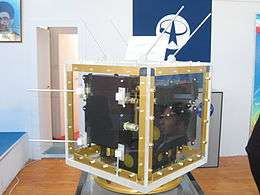Omid
Omid (Persian: امید, meaning "Hope")[2] was Iran's first domestically made satellite.[3][4] Omid was a data-processing satellite for research and telecommunications; Iran's state television reported that it was successfully launched on 2 February 2009.[4][5][6] After being launched by an Iranian-made carrier rocket, Safir 1, the satellite was placed into a low Earth orbit. The launch, which coincided with the 30th anniversary of the Iranian Revolution and was supervised by President Mahmoud Ahmadinejad, was also verified by NASA the following day as a success.[7][8] Its Satellite Catalog Number or USSPACECOM object number is 33506.
 | |
| Operator | ISA |
|---|---|
| COSPAR ID | 2009-004A |
| SATCAT no. | 33506 |
| Spacecraft properties | |
| Launch mass | 26kg |
| Start of mission | |
| Launch date | 2 February 2009 |
| Rocket | Safir-1 |
| Launch site | Semnan |
| End of mission | |
| Deactivated | April 2009 |
| Decay date | 25 April 2009 |
| Orbital parameters | |
| Reference system | Geocentric |
| Regime | Low Earth |
| Eccentricity | 0 |
| Perigee altitude | 258 kilometres (160 mi) |
| Apogee altitude | 364.8 kilometres (226.7 mi) |
| Inclination | 55.5 degrees |
| Period | 90.7 minutes |
| Epoch | 2 February 2009, 13:34:00 UTC[1] |
Ahmadinejad said the satellite was launched to spread "monotheism, peace and justice" in the world.[9] The Tehran Times reported that "Iran has said it wants to put its own satellites into orbit to monitor natural disasters in the earthquake-prone nation and improve its telecommunications."[10] Foreign minister Manouchehr Mottaki said the satellite was launched to "meet the needs of the country" and is "purely for peaceful purposes".[9] Since there was very little encryption on the satellite, data could be collected and read by citizens.[11]
Omid had the shape of a 40-centimeter (16 in) cube with mass of 27 kilograms (60 lb). Sources in the Iranian Space Agency say the satellite's sole payload was a store and forward telecommunication capability.[6]
The launch of Omid makes Iran the ninth country to develop an indigenous satellite launch capability.
Specifications
- Store and Forward Telecommunication Satellite
- Dimensions: 40 cm * 40 cm * 40 cm
- Weight: 27 kg
- Thermal Control: Passive
- Frequency Band: UHF
- Nodal Period: 90.7minutes
- Inclination: 55.71degrees
- Apogee: 381.2 km
- Perigee: 245.5 km
Previous Iranian satellites
Omid was the second Iranian satellite to be placed into orbit. A previous Iranian satellite, Sina-1, was built and launched for Iran by Russia in 2005.[12][13]
Test launch
Speaking at the opening of a new space centre on 4 February 2008, President Ahmadinejad announced that Omid would be launched in "the near future".[14] On 17 August 2008, Iranian officials reported that a test of the satellite carrier was performed, and footage was broadcast of the launch of the Safir rocket in darkness.[15]
According to an American official, "The vehicle failed shortly after liftoff and in no way reached its intended position."[16] Iranian officials released a statement denouncing the allegations as propaganda and stated the Iran would soon launch the Omid satellite.[17]
Orbit
The satellite was launched southeast over the Indian Ocean to avoid overflying neighboring countries and was placed into an orbit with an inclination of 55.5 degrees,[18] with a perigee of 246 km, an apogee of 377 km, and a period of 90.76 minutes.[19]
End of mission
Omid was reported to have successfully completed its mission without any problems. It completed more than 700 orbits over seven weeks.[20] According to U.S. Strategic Command, the Omid satellite reentered Earth's atmosphere on 25 April 2009, during an 8-hour window centered on 0342 UT. The most likely reentry location was over the south Atlantic Ocean approximately east of Buenos Aires, Argentina. No sightings were reported.[21] The rocket body from the launch, which had also entered orbit, reentered the atmosphere 31 May 2009.[22]
Further launches
Iran launched Rasad 1 on 15 June 2011 which orbited for three weeks.
See also
- Iranian Space Agency
- List of orbits
- Safir (rocket)
- Sina-1
- Timeline of first orbital launches by country
| Wikimedia Commons has media related to Omid. |
References
- "NASA - NSSDCA - Spacecraft - Trajectory Details". nssdc.gsfc.nasa.gov. Retrieved 2018-05-02.
- "Iran launches first space research center". individual.com. February 4, 2008. Archived from the original on May 7, 2008. Retrieved 2008-02-04.
- "Omid boosts Iran's Space Capabilities". ASM Magazine. May 5, 2009. Archived from the original on July 31, 2010. Retrieved 2009-05-05.
- Fredrik Dahl and Edmund Blair (February 3, 2009). "Iran launches first home-made satellite: state TV". Reuters. Retrieved Feb 3, 2009.
- "Iran puts Omid data-processing satellite into orbit". IRNA. 2009-02-03. Archived from the original on 2009-02-06. Retrieved 2009-02-03.
- "OMID Satellite Launch Report" (PDF). Iranian Space Agency. 9 February 2009. Retrieved 2009-03-15. Cite journal requires
|journal=(help) - "NASA NSSDC Master Catalog". NASA NSSDC. 1 June 2009.
- UK Guardian, 3 Feb 2009, President Ahmadinejad announcing the launch.
- "Iran launches homegrown satellite". BBC News. 2009-02-03. Retrieved 2009-02-04.
- "Iran's Omid satellite launched into orbit". 2009-02-04. Retrieved 2009-02-15.
- http://www.r00t.cz/Sats/Omid
- "Iran space rocket successfully transmits data". USA Today. 2008-02-17. Retrieved 2009-02-04.
- "First Iranian satellite launched". BBC. 27 October 2005. Retrieved 2008-08-17.
- "DEBKAfile - Iran launches first space research rocket Safir 1".
- "Iran launches satellite carrier". BBC News. 2008-08-17. Retrieved 2008-08-17.
- Reuters.com
- Presstv.ir
- Stephen Clark (February 3, 2009). "Iran puts satellite into Earth orbit". Spaceflight Now.
- "Omid - Orbit Data". Heavens Above. Retrieved 2009-02-04.
- "Omid Mission Accomplishment". PressTv.ir. Retrieved 2009-04-12.
- Spaceweather.com
- "SPACEWARN Bulletin 667". NASA NSSDC. 1 June 2009.